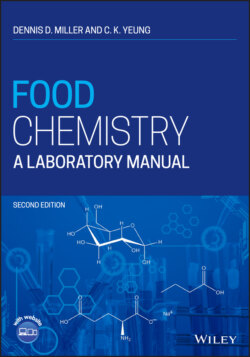Читать книгу Food Chemistry - Dennis D. Miller - Страница 31
2.2.1.2 Baking Powders
ОглавлениеGenerally, baking powders contain three materials: (i) a CO2 source, (ii) one or more leavening acids, and (iii) a diluent or filler.
CO2 Source: Sodium bicarbonate is the most commonly used source of CO2 (Eq. 3). Ammonium bicarbonate is sometimes used in cookies and crackers; however, care must be taken to remove any residual NH3 gas formed during decomposition in order to alleviate off‐flavors (Eq. 2). Sodium bicarbonate dissolves almost instantly but requires some form of acid to release the CO2 (Eq. 3). Thus, the rate and degree of dissolution of the acid in baking powders governs the rate of CO2 release. Thermal decomposition of sodium bicarbonate does not occur to any large extent, except under conditions of excess soda and/or very high temperatures.
Leavening Acids: Leavening acids that react with bicarbonate to release CO2 rapidly when water or milk is added are called “fast‐acting.” “Slow‐acting” acids react more slowly because they dissolve slowly at room temperature. Little CO2 is liberated by slow‐acting acids until the system is heated. Heating increases the rate of dissolution thereby increasing the rate of CO2 generation [1]. A description of some common leavening acids used in baking powders follows:Monocalcium phosphate monohydrate (MCP‐H2O): Ca(H2PO4)2 .H2O. This leavening acid is used in most household baking powders. It is “fast‐acting.” In solution, it dissociates to form Ca2+ and H2PO4 −. The pKa of H2PO4 − is 7.21 while the pKa of HCO3 − is 10.33. Thus, H2PO4 − is a much stronger acid than HCO3 − and readily donates a proton to HCO3 − which, in this case, acts as a base:(4) One advantage of monocalcium phosphate over some other leavening acids is that it does not contain sodium.Sodium Aluminum Sulfate (SAS): Na2SO4‐Al2(SO4)3. SAS is frequently used in combination with MCP‐H2O in household baking powders to produce a so‐called “double‐acting” baking powder. SAS releases CO2 from soda only at elevated temperatures. Excess SAS may adversely affect the flour gluten causing finished products to have a dull color and slightly bitter taste [1]. Acid is produced when Al2(SO4)3 reacts with water to form sulfuric acid:(5) Once formed, sulfuric acid, a strong mineral acid, reacts rapidly with bicarbonate to generate CO2.Potassium Hydrogen Tartrate (Cream of Tartar): KHC4H4O6. Cream of tartar, a fast leavening acid, is not widely used in commercial baking powder formulations. It may be used in angel food cakes. Tartaric acid itself (H2C4H4O6) is a fast‐acting acid and may be used in combination with the tartrate salt.Coated Anhydrous Monocalcium Phosphate. Coating MCP with slightly soluble compounds converts it to a slow‐acting acid. Coatings may include slightly soluble calcium and aluminum phosphates.Glucono‐delta‐lactone (GDL). This is a slow‐acting acid and is stable in refrigerated and frozen doughs. Lactones are cyclic esters formed when alcohol and carboxylic acid groups on the same molecule react. GDL hydrolyzes slowly in water to yield gluconic acid.(6)Sodium Acid Pyrophosphate (SAPP): Na2H2P2O7. SAPP is available in several grades produced by varying manufacturing conditions. The different grades are identified by numbers which are related to rates of reaction with sodium bicarbonate at room temperature. For example, SAPP‐21, SAPP‐28, and SAPP‐40 represent grades with increasing reaction rates. SAPP‐21 is used when there is a delay between mixing and baking, for example in refrigerated biscuits [2].Sodium Aluminum Phosphate (SALP). NaAl3H14(PO4)8 .4H2O. A slow‐acting acid, SALP has replaced by SAPP in some applications because SAPP residual salts may impart an off‐flavor.Other Food Ingredients. Sour milk, cultured buttermilk, molasses, and ionic flour proteins are all acidic and therefore can act as leavening acids.
Diluents: Diluents are added to baking powders to prevent premature reaction of the sodium bicarbonate and acid, i.e. to provide physical separation of soda and acid, and to increase the bulk which makes measuring small quantities of sodium bicarbonate and leavening acid easier. Corn starch is the most common diluent. FDA requires that baking powders yield at least 12 g of CO2 for every 100 g of powder. In order to achieve this, most formulations contain 26–30% sodium bicarbonate [3–5].
